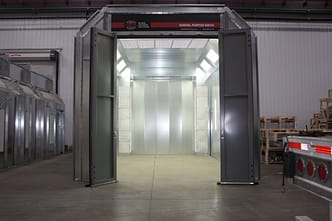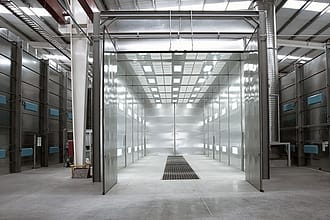Regardless of what kind of equipment you have or what kind of business you run, you can get your questions answered by the GFS experts. Here are just a few of the questions we’ve received so far from the community, and we will continue to make these answers available to everyone here on the Booth Blog.
“How many types of paint booths are there?“
This is a tough question to answer, as they are many different “types” of paint booths in terms of airflow style, cabin design, ceiling and pit design, size and features. Booths can be completely enclosed or open in the front (i.e. “open-face”). There is also the main difference between liquid and powder coating booths. For liquid finishing, the two basic types are dry filter booths and water wash booths. For powder coating, there are different styles of powder recovery booths.


Several factors must be considered when determining the appropriate spray booth design for your application.
“What is the maximum temperature inside a paint booth?“
The maximum temperature in the spray area of an enclosed spray booth is 200°F, per NFPA 33 – Standard for Spray Application Using Flammable or Combustible Materials. This temperature can be reached in most recirculating spray booths. Quite often there is no need to reach that temperature, since the spray area only needs to get hot enough to cure the paint. Contact the paint manufacturer to learn the optimal temperature for curing.
“How far does a baking booth have to be from the actual paint booth?“
It depends. NFPA 33 requires that booths shall be separated from other operations by a minimum distance of 3 feet or by a partition or wall having a minimum fire resistance rating of 1 hour. This allows access for cleaning and maintenance and minimizes the potential for the spread of fire. However, you may connect your spray booth directly to your oven so that the product can be moved directly from one to the other. If you do, interconnecting doors shall include an interlock to prevent spraying if the doors are open.
A high-temperature limit is required in the spray area to shut down the oven heating system if the temperature in the booth exceeds 200 F. If your process does not allow for interconnecting doors, then you need a pressurized vestibule between your booth and oven. The vestibule must separate the booth from the oven by at least 3 feet. Airflow into the vestibule must be proven so that a loss of airflow shuts down either the oven heating system or the spray application equipment.
One of the best ways to highlight your business is through a story that you can share across your online platforms. It humanizes your business and shows that your business can make a meaningful impact. Your testimonial would be used as a project profile on the GFS Booth Blog and can be shared on your website and/or social media channels.
Complete this form and we’ll be in touch to showcase your company.

Shop a variety of GFS aftermarket products, including booth protection products and mobile accelerated curing units. And enjoy the convenience of fast and free ground shipping throughout the contiguous United States.

Located at GFS’ headquarters in Osseo, Wisconsin, the Center for Excellence is an innovative facility featuring an automotive refinish training center, as well as a separate space dedicated to technical product training.

GFS is continuously searching for talented, ambitious individuals to join our team. We aim to provide our employees with every opportunity to make an impact on the company and find their niche along the way — weather in a production, field services or an office position.